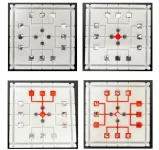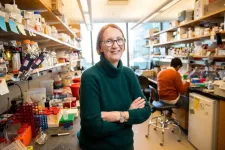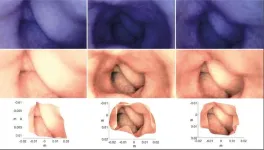(Press-News.org) WASHINGTON, June 25, 2024 – Every so often, a food product is recalled because of some sort of contamination. For consumers of such products, a recall can trigger doubt in the safety and reliability of what they eat and drink. In many cases, a recall will come too late to keep some people from getting ill.
In spite of the food industry’s efforts to fight pathogens, products are still contaminated and people still get sick. Much of the problem stems from the tools available to screen for harmful pathogens, which are often not effective enough at protecting the public.
In AIP Advances, by AIP Publishing, researchers from Guangdong University of Technology and Pudong New District People’s Hospital developed a new method for detecting foodborne pathogens that is faster, cheaper, and more effective than existing methods. The researchers hope their technique can improve screening processes and keep contaminated food out of the hands of consumers.
Even with the best detection method, finding contaminating pathogens is not an easy task.
“Detecting these pathogens is challenging, due to their diverse nature and the various environments in which they can thrive,” said author Silu Feng. “Additionally, low concentrations of pathogens in large food samples, the presence of similar non-pathogenic organisms, and the complex nature of different food types make accurate and rapid detection difficult.”
Existing detection methods do exist, such as cell culture and DNA sequencing, but are challenging to employ at large scales. Not every batch of food can be thoroughly tested, so some contaminants inevitably slip through.
“Overall, these methods face limitations such as lengthy result times, the need for specialized equipment and trained personnel, and challenges in detecting multiple pathogens simultaneously, highlighting the need for improved detection techniques,” said Feng.
The study’s authors decided to take a different approach, designing a microfluidic chip that uses light to detect multiple types of pathogens simultaneously. Their chip is created using 3D printing, making it easy to fabricate in large amounts and modify to target specific pathogens.
The chip is split into four sections, each of which is tailored to detect a specific pathogen. If that pathogen is present in the sample, it will bind to a detection surface and change its optical properties. This arrangement let the researchers detect several common bacteria, such as E. coli, salmonella, listeria, and S. aureus, quickly and at very low concentrations.
“This method can quickly and effectively detect multiple different pathogens, and the detection results are easy to interpret, significantly improving detection efficiency,” said Feng.
The team plans to continue developing their device to make it even more applicable for food screening.
###
The article "3D-printed microfluidic chip integrated with nanointerferometer for multiplex detection of foodborne pathogens" is authored by Silu Feng, Kongjin Mo, and Xin Song. It will appear in AIP Advances on June 25, 2024 (DOI: 10.1063/5.0208274). After that date, it can be accessed at https://doi.org/10.1063/5.0208274.
ABOUT THE JOURNAL
AIP Advances is an open access journal publishing in all areas of physical sciences—applied, theoretical, and experimental. The inclusive scope of AIP Advances makes it an essential outlet for scientists across the physical sciences. See https://aip.scitation.org/journal/adv.
###
END
3D-printed chip sensor detects foodborne pathogens for safer products
Chip design can rapidly and efficiently test for multiple pathogens simultaneously, potentially reducing foodborne illness
2024-06-25
ELSE PRESS RELEASES FROM THIS DATE:
A model of Collaborative Ethics to guide translational research from fundamental discoveries to real-world applications
2024-06-25
By Benjamin Boettner
(BOSTON) — In sciences, disruptive research that is breaking new ground often raises new and not-yet-explored ethical questions. Although new scientific breakthroughs can have the power to change how we understand and live in the world, the ethical implications of technologies that will emerge based on these new insights can affect an emerging field’s public acceptance and have moral implications for society at large. They can also impact the process of translating discoveries into real-world products, sometimes requiring new regulation.
Historically, ethicists – who form the branch of philosophy that is concerned with morality and studies ...
Frauke Gräter appointed new director at the Max Planck Institute for Polymer Research
2024-06-25
How can artificial intelligence and machine learning be used for innovative research in the field of soft matter? Frauke Gräter, the current Head of the Molecular Biomechanics group at the Heidelberg Institute for Theoretical Studies (HITS) and Professor of Molecular Biomechanics at Heidelberg University, will research these and other topics as the new Director at the MPI for Polymer Research starting July 1, 2024.
Frauke Gräter has made an international name for herself through her outstanding scientific contributions, particularly in the field of molecular biomechanics. Her academic ...
Scientists demonstrate for first the time that a group of butterflies flies across the Atlantic Ocean
2024-06-25
An international team of researchers, led by the Spanish National Research Council (CSIC), has documented a transoceanic flight of more than 4200 km by painted lady butterflies (Vanessa cardui), setting a record for an insect.
The study, published in the journal Nature Communications, involved researchers from the Botanical Institute of Barcelona (IBB), a joint center of the CSIC and the Natural Sciences Museum of Barcelona, as well as from the W. Szafer Botanical Institute (Poland), the University of Ottawa (Canada), the Institute of Evolutionary ...
Oncolytic virus senecavirus A inhibits hepatocellular carcinoma proliferation and growth by inducing cell cycle arrest and apoptosis
2024-06-25
Background and Aims
Hepatocellular carcinoma (HCC) is a highly aggressive tumor with limited treatment options and high mortality. Senecavirus A (SVA) has shown potential in selectively targeting tumors while sparing healthy tissues. This study aimed to investigate the effects of SVA on HCC cells in vitro and in vivo and to elucidate its mechanisms of action.
Methods
The cell counting kit-8 assay and colony formation assay were conducted to examine cell proliferation. Flow cytometry and nuclear staining were employed to analyze cell cycle distribution and apoptosis occurrence. ...
Brain connectivity on MRI predicts Parkinson’s disease progression
2024-06-25
OAK BROOK, Ill. – The structural and functional organization of the brain as shown on MRI can predict the progression of brain atrophy in patients with early-stage, mild Parkinson’s disease, according to a study published today in Radiology, a journal of the Radiological Society of North America (RSNA).
Parkinson’s disease is a progressive disorder characterized by tremors, slowness of movement or rigidity. Symptoms worsen over time and may include cognitive impairment and sleep problems. The disease affects more than 8.5 million people worldwide, and prevalence has doubled in the past 25 years, according to the World Health Organization (WHO).
One of ...
Carnegie Mellon University School of Computer Science launches CMU TechBridge Coding Bootcamp
2024-06-25
The School of Computer Science at Carnegie Mellon University has launched the CMU TechBridge Coding Bootcamp to provide access to computer science education and career opportunities for high school (or equivalent) graduates.
The bootcamp will extend the reach of CMU’s computer science education offerings beyond its traditional undergraduate and graduate programs. CMU has partnered with TalentSprint to implement the program to help aspiring professionals build the skills required for launching and ...
Weill Cornell Medicine awarded Department of Defense grant for prostate cancer bone metastases research
2024-06-25
Weill Cornell Medicine received a $1.5 million grant from the U.S. Department of Defense Prostate Cancer Research Program to develop new approaches for predicting the spread of cancer cells to the bone in men with prostate cancer, using tumor samples taken at early stages of the disease.
The American Cancer Society projects about 35,250 deaths from prostate cancer in the United States in 2024. “Metastases, especially to the bone, is the leading cause of death in men who have prostate cancer,” said principal investigator Dr. Mohamed Omar, assistant professor of research in pathology and laboratory medicine, division ...
New 3D models of the colon can help detect disease more rapidly
2024-06-25
“Our work shows that it is possible to re-create a fairly accurate three-dimensional (3D) model of the colon of some patients based on a single image taken by a capsule endoscopy camera - even if it's a low-quality image,” says Pål Anders Floor, a researcher at the Department of Computer Science at NTNU.
Goal: better images, faster diagnoses
He has been working for several years on using images from capsule endoscopy cameras to reconstruct an almost identical 3D model of the intestines. These cameras were first used more than 20 years ago, but low-quality images and image noise prevented this smart technology from ...
Study challenges ED protocols for geriatric head injuries and blood thinners
2024-06-25
Falls are the most common cause of injury among adults 65 and older in the United States. According to the U.S. Centers for Disease Control and Prevention, every year, more than 14 million older adults (one in four) report a fall. About 90% of head injuries among older individuals is due to ground-level falls.
Evaluating an older adult with a head injury in the emergency department (ED) requires careful assessment due to the increased risk of complications such as intracranial hemorrhage. There also is heightened concern for older patients taking anticoagulants or blood thinners who sustain ...
Team aims to improve safety of fertilizers made from wastewater sludge
2024-06-25
Fertilizers manufactured from the sludgy leftovers of wastewater treatment processes can contain traces of potentially hazardous organic chemicals, according to a new study by Johns Hopkins University researchers.
The research, published today in Environmental Science & Technology journal, provides one of the most comprehensive looks at the chemical composition of so-called biosolids across the country and is the first step toward identifying common chemical contaminants that may need government regulation. The findings could ...
LAST 30 PRESS RELEASES:
Exploring why adapting to the environment is more difficult as people age
Society for Laboratory Automation and Screening welcomes new scientific director: Madeline M. Farley, Ph.D.
Austrian cow shows first case of flexible, multi-purpose tool use in cattle
Human nasal passages defend against the common cold and help determine how sick we get
Research alert: Spreading drug costs over the year may ease financial burden for Medicare cancer patients
Hospital partnership improves follow up scans, decreases long term risk after aortic repair
Layered hydrogen silicane for safe, lightweight, and energy-efficient hydrogen carrier
Observing positronium beam as a quantum matter wave for the first time
IEEE study investigates the effects of pointing error on quantum key distribution systems
Analyzing submerged fault structures to predict future earthquakes in Türkiye
Quantum ‘alchemy’ made feasible with excitons
‘Revoice’ device gives stroke patients their voice back
USF-led study: AI helps reveal global surge in floating algae
New method predicts asthma attacks up to five years in advance
Researchers publish first ever structural engineering manual for bamboo
National poll: Less than half of parents say swearing is never OK for kids
Decades of suffering: Long-term mental health outcomes of Kurdish chemical gas attacks
Interactional dynamics of self-assessment and advice in peer reflection on microteaching
When aging affects the young: Revealing the weight of caregiving on teenagers
Can Canada’s health systems handle increased demand during FIFA World Cup?
Autistic and non-autistic faces may “speak a different language” when expressing emotion
No clear evidence that cannabis-based medicines relieve chronic nerve pain
Pioneering second-order nonlinear vibrational nanoscopy for interfacial molecular systems beyond the diffraction limit
Bottleneck in hydrogen distribution jeopardises billions in clean energy
Lung cancer death rates among women in Europe are finally levelling off
Scientists trace microplastics in fertilizer from fields to the beach
The Lancet Obstetrics, Gynecology, & Women’s Health: Taking paracetamol during pregnancy does not increase risk of autism, ADHD or intellectual disabilities, confirms new gold-standard evidence review
Taking paracetamol during pregnancy does not increase risk of autism, ADHD or intellectual disabilities
Harm reduction vending machines in New York State expand access to overdose treatment and drug test strips, UB studies confirm
University of Phoenix releases white paper on Credit for Prior Learning as a catalyst for internal mobility and retention
[Press-News.org] 3D-printed chip sensor detects foodborne pathogens for safer productsChip design can rapidly and efficiently test for multiple pathogens simultaneously, potentially reducing foodborne illness







